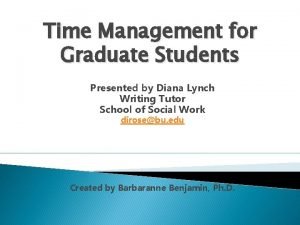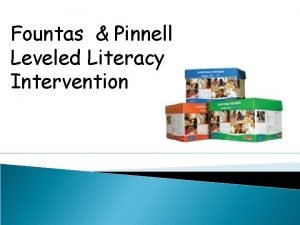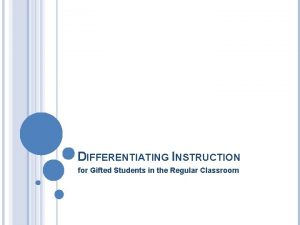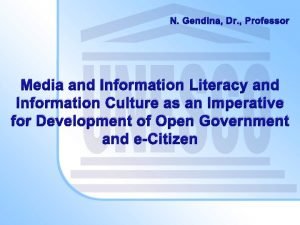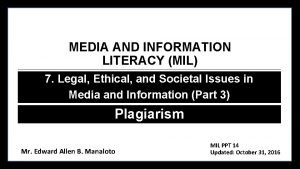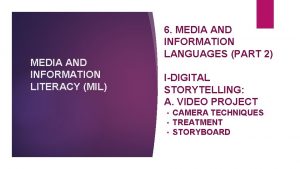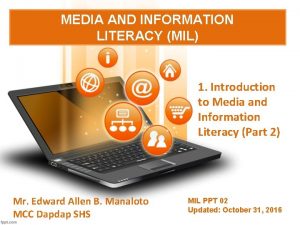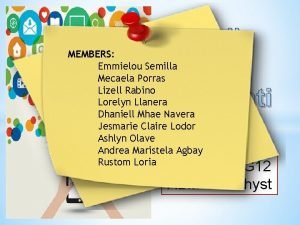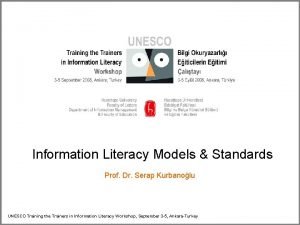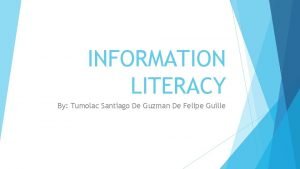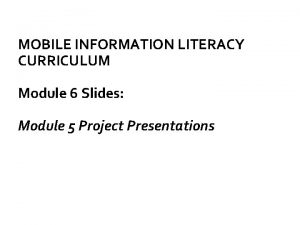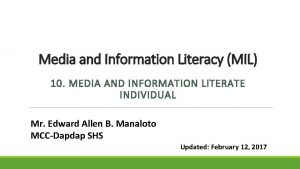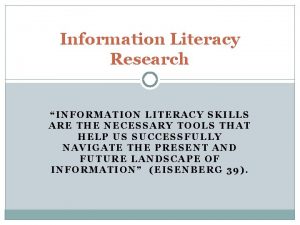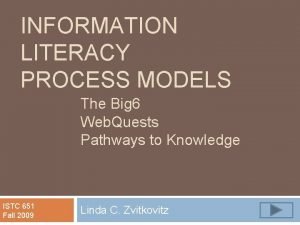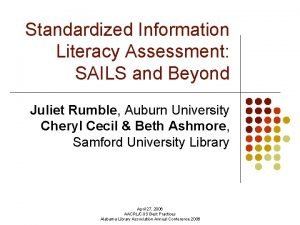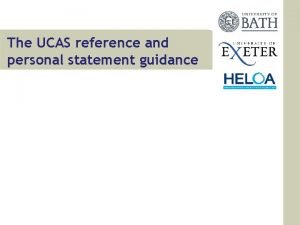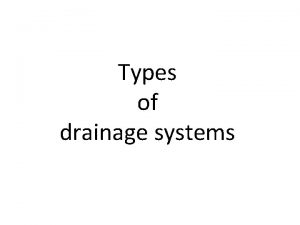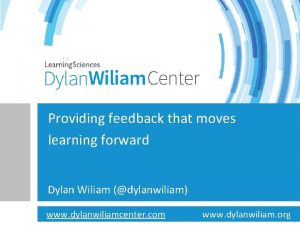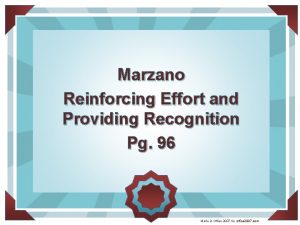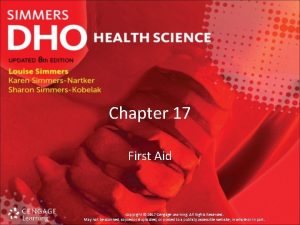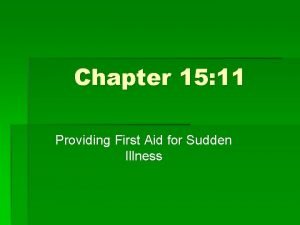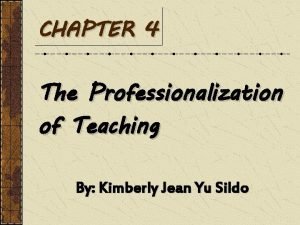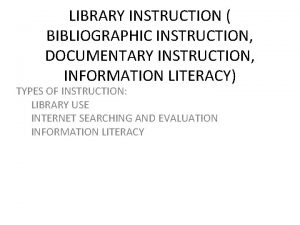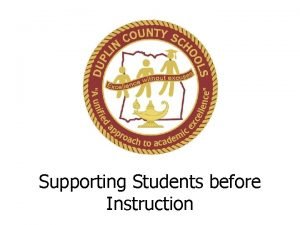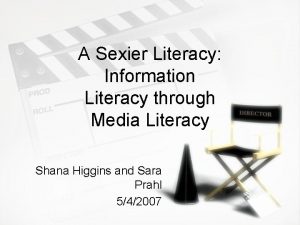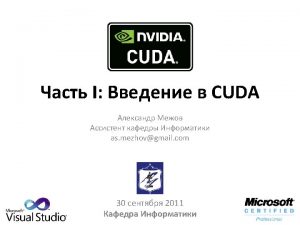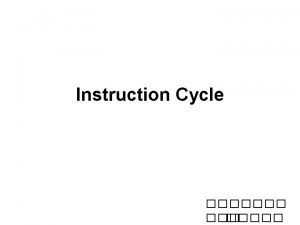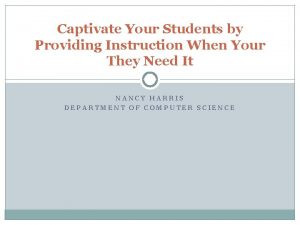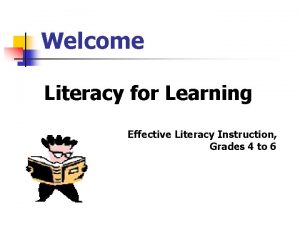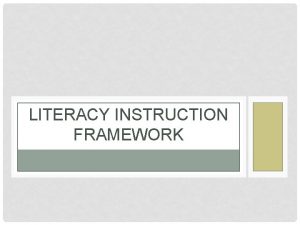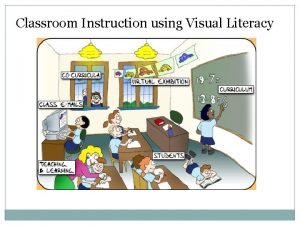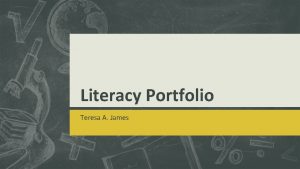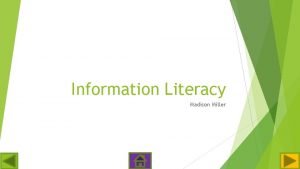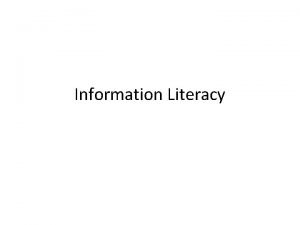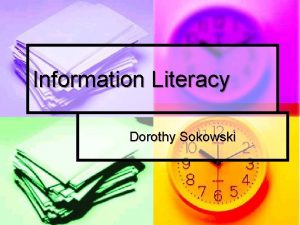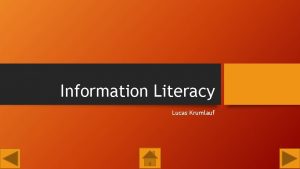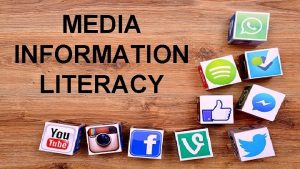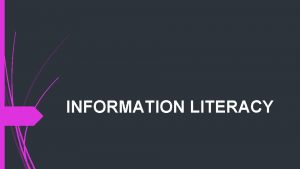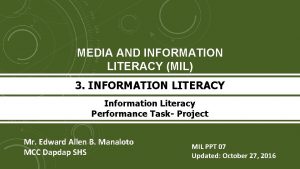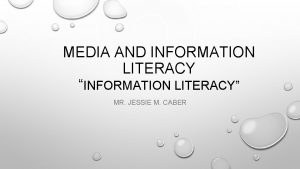Graduate Students Providing Information Literacy Instruction to Graduate







































- Slides: 39

Graduate Students Providing Information Literacy Instruction to Graduate Students Hannah Gascho Rempel Graduate Student Services Coordinator, Oregon State University OLA/WLA Conference April 18, 2008

Graduate Students Where We’re Headed Today • Who are our graduate students anyway? • What are their information literacy needs? • Some ideas for providing instructional services (Example – OSU Libraries)

Graduate Students Why Focus on Graduate Students? • • Traditionally underserved Future faculty Part of our strategic direction Personal interest

Graduate Students Who Are They?

Graduate Students dsandler – Rice University

Graduate Students Grad Student Facts & Figures • 13. 9% of all students enrolled nationally (2001 – U. S. Dept. of Ed. , Pontius & Harper, 2006) OUS 2006 Factbook

Graduate Students Grad Student Facts & Figures • 28% are members of minority groups (U. S. citizens) – (In Oregon 10. 6%) – 13% - African-Americans – 8% - Hispanic – 6% - Asian/Pacific Islander – 1% Native American • 16% are international students Council of Graduate Schools, 2007

Graduate Students Grad Student Facts & Figures • 59% are female (65% at master’s-only institutions) – Oregon 58% F, 42% M Council of Graduate Schools, 2007; OUS 2006 Factbook

Graduate Students Grad Student Facts & Figures • Oregon 58% F, 42% M OUS 2006 Factbook

Graduate Students Grad Student Facts & Figures Areas of Study • Education (74% female) and business (55% male) were the most popular disciplines • Health sciences is the fastest growing field • 53% of international students studied either engineering or sciences; only 16% of U. S. students did Council of Graduate Schools, 2007

Graduate Students Grad Student Facts & Figures • Grad students are adults OUS 2006 Factbook

Graduate Students Grad Student Facts & Figures • 33 – average at dissertation completion (Brus, 2006) • 25% - have at least one minor dependent (U. of Iowa study, Brus, 2006) • Only at the largest doctoral universities did a majority (67%) attend full-time (CGS, 2007) leahleaf

Nontraditional Graduate Students Twenty-two to thirty years old Over thirty years old Primarily Caucasian Often from underrepresented populations; may be based on race, ethnicity, or gender Primarily from families with higher socioeconomic status Single, partnered, or married students with no children Often from families with lower socioeconomic status Married or single-parent students with dependent children Parents provide financial and Parents increasingly emotional support to the dependent on the student for student financial and emotional support Brus, 2006 Graduate Students Traditional Graduate Students

Graduate Students Traditional Graduate Students • Fewer hours of paid work Nontraditional Graduate Students • More hours of paid work • Fewer general time constraints • More opportunity for social interaction • More personal time for recreation and relaxation • More academic flexibility • Greater general time constraints • Less opportunity for social interaction • Less personal time for recreation and relaxation • Less academic flexibility Brus, 2006

Graduate Students Traditional Graduate Students Nontraditional Graduate Students • More time on campus • Less time on campus • More visibility in academic department • Less visibility in academic department • More opportunities to network • Fewer opportunities to network • More availability on short notice • Less availability on short notice • Increased probability of being mentored • Primary obligation is to excel in school • Decreased probability of being mentored • Primary responsibility is the welfare of their family Brus, 2006

Graduate Students Grad Student Facts & Figures Depressing Facts • 49% of humanities students finish their dissertation in 10 years (as opposed to 63. 8% of life science and 64. 4% of engineering students) • 38% of humanities students finish at least $35 K in debt vs. 12% of engineering and 18% of life science students Council of Graduate Schools, 2007

Graduate Students Ph. D. Completion Factors • • • 80% - financial support 63% - mentoring/advising 60% - family support 39% - social environment & peer support 39% - program quality 30% - professional and career guidance Council of Graduate Schools, 2007

Graduate Students Working with Adult Learners

Graduate Students Working with Adult Learners • Adult learners bring their own learning preferences and needs – Expect to be accountable for more self-directed learning – Prefer learning through hands-on experience – Enjoy learning that addresses a specific problem – Typically have many more demands on their time, when compared with traditional-age students, due to family and work responsibilities. (Dewald 1999; Ross-Gordon 2003)

Graduate Students Graduate Student Info Seeking Behaviors • Learn from their peers (Brown 2005; Kuruppu and Gruber 2006) • Lack of time impacts willingness to try new library tools and techniques • Primarily use journal articles rather than books (Parrish 1989; Sadler and Given 2007) (Chrzastowski and Joseph 2006) • Prefer electronic access (Chrzastowski and Joseph 2006) • Desire cross-database searching (Maughan 1999) OSU Libraries

Graduate Students Graduate Student Needs • Increase information literacy skills • Space to study/research/ write/collaborate • Community to interact with (“Community of Scholars”) cayce. vanhorn – Auburn University Libraries ARL/CNI Fall Forum 2007 Report

Graduate Students Why Grad Students Are Often Underserved • The undergraduate population is so much bigger • Undergraduate student development arguably requires more attention and resources • The perception that academic programs and departments already meet the needs of grad students • Grad students are experienced students – know how to navigate the higher ed system Pontius & Harper, 2006

Graduate Students Traditional Barriers • Assumptions about level of familiarity and knowledge – By librarians – By faculty – By students themselves • Lack of a traditional access point

Graduate Students Traditional Service Points • Orientations • Tool-specific classes • Research consultations • Reference Desk spencerselvidge

Graduate Students Creating a Graduate Student Services Program Departmental Shifts Appointed a Coordinator Surveyed Student Needs Looked for the point of greatest impact Chose an instructional style Promoted Workshop Evaluated Workshop Expanded Options

Graduate Students Why the Literature Review? • Survey results • Our own experiences as grad students (and librarians) • Common across departments • Specific, required information need • Great lead in for many IL competencies – Determining info needed, accessing, evaluating, incorporating, using effectively

Graduate Students Why a Workshop? • • • Separate from a specific course Broad reach Interactive environment Realistic post-school setting Elements we included – Pre-registration, confirmation reminders, personalized packets, name tags, food and drink, seating, conversational tone, group work

Graduate Students Workshop Promotion • Find the most effective means for your setting • Try multiple avenues – Posters, handouts, emails from subject librarians, emails from grad advisors • Evaluate what actually worked

Graduate Students What We Cover • • • Definition and purpose of the literature review Communicating with your advisor Comprehensiveness Strategies for conducting a literature review Learning how to read and recognize patterns in the literature Effective database searching • Useful library services (e. g. interlibrary loan) • Organizing searches and results (e. g. , saving searches, bibliographic management software) • Keeping up with the literature (RSS feeds, Table of Contents alerts, social bookmarking, search alerts) • Contacts for further help and participant evaluation of workshop

Graduate Students Evaluation • Pre-Assessment – Length of time at OSU? – Masters or Ph. D. student? – ILL use? – Summit use? – What article databases have you used? – What do you want to learn?

Graduate Students Pre-Assessment Findings

Graduate Students Pre-Assessment Findings

Graduate Students Pre-Assessment Findings

Graduate Students Pre-Assessment Findings

Graduate Students Evaluation – Post Workshop • Self-assessment of learning • Review of how we did • What they would like to learn in the future

Graduate Students Post Workshop Findings

Graduate Students Future areas to explore • Target specific audiences – international students, older than average students, or distance learners • Offer classes for a range of skill levels • Involve faculty • Increase thesis writing support for graduate students (based on requests on student evals) – Partner with writing center, academic departments to explore options • Make other library workshop offerings available to graduate students • Provide resources for grad students in their role as teachers and researchers (not just students)

Graduate Students Screenshot of Current Workshop Offerings

Graduate Students Summary • Consider your audience • Create programs that meet a need
 Venn diagram of media information and technology literacy
Venn diagram of media information and technology literacy Media and information literacy venn diagram
Media and information literacy venn diagram What's
What's Cyber literacy for the digital age
Cyber literacy for the digital age Time management for graduate students
Time management for graduate students Lli fountas and pinnell
Lli fountas and pinnell Individualized instruction vs differentiated instruction
Individualized instruction vs differentiated instruction Difference between direct and indirect instruction
Difference between direct and indirect instruction Gifted choice boards
Gifted choice boards Vicenta ybardaloza
Vicenta ybardaloza Alice porter murray
Alice porter murray Power of media and information
Power of media and information Mind map about media and information literacy
Mind map about media and information literacy The forgotten footnote
The forgotten footnote Performance task for media and information literacy
Performance task for media and information literacy Cartoon analysis about media
Cartoon analysis about media Typewriter (1800)telephone (1876)
Typewriter (1800)telephone (1876) Principles of information systems
Principles of information systems Anziil
Anziil Disaster scenario according to the weather forecast
Disaster scenario according to the weather forecast Media and information literacy module 6
Media and information literacy module 6 Graphic organizer about media and information literacy
Graphic organizer about media and information literacy Big six information literacy skills
Big six information literacy skills Big six model of information literacy
Big six model of information literacy Sails information literacy
Sails information literacy Personal information examples for students
Personal information examples for students Unit 15:8 providing first aid for cold exposure
Unit 15:8 providing first aid for cold exposure Two pipe system drainage
Two pipe system drainage Feedback
Feedback Feedback dylan wiliam
Feedback dylan wiliam Where is the valet within the enterprise
Where is the valet within the enterprise Accept housekeeping request from guest
Accept housekeeping request from guest Engineering controls examples
Engineering controls examples Who is responsible for providing specialized work footwear?
Who is responsible for providing specialized work footwear? Reinforcing effort and providing recognition examples
Reinforcing effort and providing recognition examples Chapter 17:6 providing first aid for burns
Chapter 17:6 providing first aid for burns Chapter 17:12 applying dressings and bandages
Chapter 17:12 applying dressings and bandages Chapter 15:3 providing first aid for bleeding and wounds
Chapter 15:3 providing first aid for bleeding and wounds 17:11 providing first aid for sudden illness
17:11 providing first aid for sudden illness Republic act 7836
Republic act 7836




